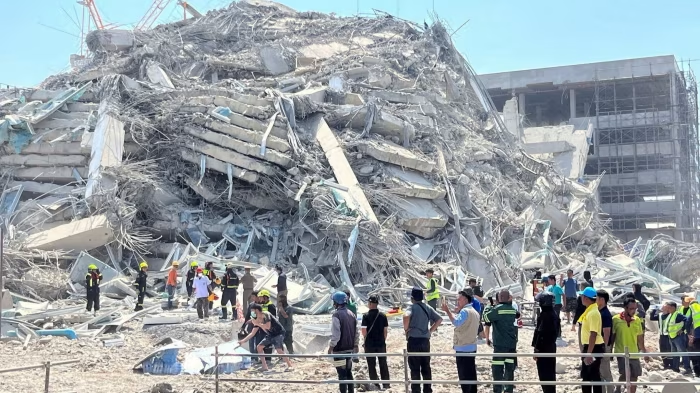
Huge earthquake hits Myanmar: Death Toll Rises, Widespread Destruction Reported
Earthquake in Myanmar – March 28, 2025: A devastating earthquake measuring 7.7 on the Richter scale struck central Myanmar on Thursday, causing extensive destruction and leading to significant casualties. The tremor was felt across the region, including in neighboring Thailand, China, and India. As authorities continue their rescue efforts, the full extent of the disaster is still being assessed.
Earthquake Details and Epicenter
The earthquake struck at approximately 12:50 PM local time. According to the United States Geological Survey (USGS), the epicenter was located about 16 kilometers north-northwest of Sagaing, near the city of Mandalay, at a shallow depth of 10 kilometers. The tremor lasted for nearly a minute, sending shockwaves across Myanmar and beyond, triggering panic among residents and causing severe structural damage.
Seismologists have warned that due to the earthquake’s shallow depth, the impact on buildings and infrastructure has been particularly devastating. The Myanmar Department of Meteorology and Hydrology has reported multiple aftershocks, some reaching magnitudes of 5.5 or higher, further exacerbating the situation.
Casualties and Damage in Myanmar
The hardest-hit areas include Sagaing, Mandalay, and Bago regions, as well as the capital city, Naypyidaw. As of the latest reports, at least 150 people have been confirmed dead, with thousands more injured. Hospitals in affected areas are overwhelmed, and emergency medical teams are struggling to provide care to the wounded.
Among the most tragic incidents was the collapse of a school building in Taungoo Township, where over 20 children and teachers were trapped. Rescue operations are underway, but officials fear the death toll could rise further. In Maha Aung Myay Township, a two-story tea shop crumbled, trapping nearly 70 individuals under the debris. In Mandalay, the earthquake caused the collapse of multiple structures, including a 90-year-old bridge and several religious sites, such as an ancient monastery.
In Sagaing, rescue workers continue to search for survivors amid the rubble of collapsed homes and commercial buildings. Witnesses reported that the powerful tremors caused walls to crack, windows to shatter, and roads to split open.
Government Response and State of Emergency
In response to the crisis, the ruling military junta has declared a state of emergency in six regions: Sagaing, Mandalay, Bago, Magway, Shan State, and Naypyidaw. Military and emergency response teams have been deployed to assist with rescue efforts.
Senior General Min Aung Hlaing, the head of Myanmar’s junta, addressed the nation, calling for calm and pledging full government support for relief operations. “We are mobilizing all available resources to aid those affected. International assistance will also be welcomed in this difficult time,” he said in a televised statement.
The junta’s appeal for international aid comes amid growing concerns over the country’s limited disaster response capabilities. Myanmar, already struggling with political instability and economic challenges, faces significant logistical hurdles in managing a catastrophe of this scale.
Impact in Thailand
The earthquake was strongly felt in Bangkok, Thailand, where it led to the partial collapse of a 30-story government office building in the Chatuchak district. At least three people have been confirmed dead, while more than 90 remain missing. Emergency response teams are working tirelessly to clear the debris and locate survivors.
In addition to Bangkok, several northern provinces of Thailand reported tremors, leading to temporary evacuations of high-rise buildings and schools. The Stock Exchange of Thailand was forced to suspend trading as a precautionary measure. Thai Prime Minister Paetongtarn Shinawatra has declared a state of emergency in Bangkok and has called for an emergency meeting to coordinate relief efforts.
Regional and International Response
Beyond Myanmar and Thailand, tremors were felt as far as China, India, and Vietnam, triggering evacuations in some areas. In India, Prime Minister Narendra Modi has expressed deep concern over the disaster and has offered humanitarian assistance to Myanmar and Thailand.
International aid organizations, including the United Nations, the Red Cross, and various NGOs, have pledged their support. Humanitarian teams are being mobilized to provide essential supplies, including food, water, medical aid, and temporary shelters for the displaced population.
Rescue and Relief Efforts
Rescue operations in Myanmar are being hampered by widespread power outages, damaged communication networks, and blocked roads. The military and local volunteers are working to clear debris and reach those trapped under collapsed buildings. However, given the extent of the destruction, officials fear that many more victims remain buried under the rubble.
Temporary shelters have been set up in open fields and school compounds to house thousands of displaced residents. Emergency relief teams are distributing food, blankets, and medical supplies, but there is an urgent need for additional support.
In Thailand, emergency responders are using specialized equipment to search for survivors in the rubble of the collapsed government building. Drones and sniffer dogs have been deployed to locate those still missing.
Economic and Infrastructure Impact
The economic impact of the earthquake is expected to be significant. Many businesses, markets, and transportation systems have been disrupted. The agricultural sector, a major component of Myanmar’s economy, is also expected to suffer heavy losses, with reports of damaged irrigation systems and farmland.
Mandalay’s iconic Royal Palace, a historic site that attracts thousands of tourists annually, sustained damage, raising concerns about the earthquake’s impact on Myanmar’s already struggling tourism industry. Several Buddhist temples and stupas in Bagan, a UNESCO World Heritage Site, have also suffered structural damage.
Looking Ahead: The Risk of Aftershocks
Seismologists have warned of the potential for more aftershocks in the coming days and weeks. Residents in affected areas have been advised to remain vigilant and to take necessary precautions.
Given Myanmar’s location along a major tectonic fault line, the country is no stranger to earthquakes. However, experts stress that better disaster preparedness, stronger infrastructure, and improved early warning systems are crucial to mitigating future tragedies.
Conclusion
As Myanmar grapples with one of the worst natural disasters in its history, the focus remains on rescue and relief efforts. The international community is rallying to assist, but the scale of the devastation presents significant challenges. With rescue operations ongoing and aftershocks still being recorded, the true toll of the disaster may not be known for some time.
For now, Myanmar mourns its losses while bracing for the difficult road to recovery ahead.




